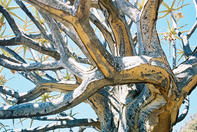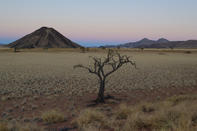Disturbing News
More recently, disturbing news emerged from Namibia suggesting that all might not be well in the kokerboomwoude (quiver tree forests) of the desert. Large numbers of quiver trees were dying out in the north of its range. Farmers in the area reported that in some communities of trees as much as half their numbers had died off. No one could explain why.

The South African National Biodiversity Institute (SANBI) decided to compare the results of bioclimatic modelling with the state of quiver trees to see if there was any correlation between the two. Conservation biologist Wendy Foden was sent off into the desert to find the culprit behind the silent deaths of the quiver tree. Starting in South Africa and moving north, Foden and her colleagues found communities of quiver trees across their distribution.
They looked at every possible cause of mortality: fungus on the leaves, daily pressure on the land from livestock, grazing by drought-hungry animals, and baboon damage. They counted the percentage of live and dead trees in each population and then had to establish a time scale in which these fatalities had occurred. Here the trees came to their assistance.
Because quiver trees show distinctive physical characteristics at different stages of life - between sapling, adolescent, adult and ageing geriatric - they are their own timeline. Knowing this, Foden had a way to measure conditions over the previous few hundred years. Looking at a stand of quivers, it's possible to calculate the gap years between periods of favourable conditions for germination. In some communities, they found smooth transitions, where all age groups were present.
But others showed that there had been few crops of seedlings in recent years. Worse still, some communities did not have any plants under adult size. Quiver trees start looking like adults at about 100 to 150 years of age. Foden's team did not find any youngsters, indicating that it had been a long time since quiver trees in those areas last experienced conditions where they were able to reproduce successfully. Skeletons also help to record the history of the trees.
Graveyard of Trees

The intensely dry conditions in the desert mean that deceased trees may remain where they die for decades - in some cases even up to a century or more. In the Richtersveld, which straddles the border between South Africa and Namibia, a 60 to 70 per cent mortality rate was found. Further north, in valleys near the Brandberg, a few hundred kilometres north of Windhoek, they found graveyards of trees with hardly a living aloe in sight.
Not only did they notice that trees were dying, but they observed a behaviour that had not been documented before. The branches of some quiver trees came to a sudden end, in a stump, as though their hands had been severed at the wrist. This was dubbed 'auto-amputation'. Quite distinguishable from baboon damage, it seemed the trees just drop their leaves off, leaving behind a stump that is rounded at the end.
By Leonie Joubert